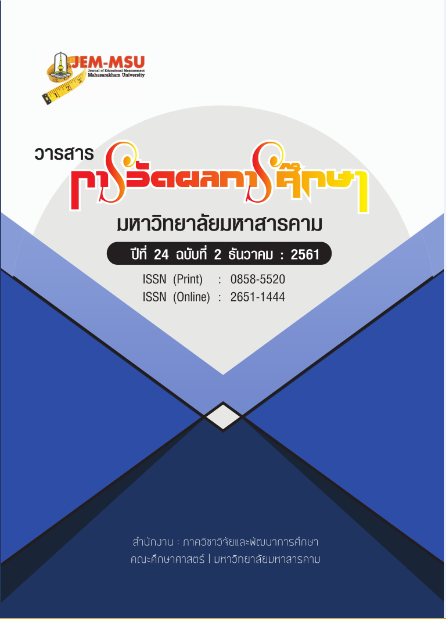The Development of Learning Activities by Using the Yonisomanasikarn Approach with Electronic Book in the Learning Strand of Social Studies, Religion and Culture of Matthayomsueksa 2
Main Article Content
Abstract
The purposes of this study were: (1) to develop the plans for organizing learning activities using the Yonisomanasikarn Approach with the electronic book which contributes to analytical thinking ability in the learning strand of social studies, religion and culture of Matthayomsueksa 2, with a required efficiency of 80/80; (2) to find the effectiveness index of the plans for organizing learning activities using the Yonisomanasikarn Approach with the electronic book in the learning strand of social studies, religion and culture of Matthayomsueksa 2; (3) to compare the learning achievements between before and after the study of students by using the Yonisomanasikarn Approach with the electronic book in the learning strand of social studies, religion and culture of Matthayomsueksa 2; (4) to compare analytical thinking ability between before and after the study of the students using the Yonisomanasikarn Approach with the electronic book. The sample used in this study consisted of one group of 35 Matthayomsueksa 2 students attending Yangtaladwittayakarn School, Yangtalad District, Kalasin Educational Area 2 in the first semester of the academic year 2017, selected through cluster random sampling technique from 6 groups, beginning from Matthayomsueksa 2/1 to Matthayomsueksa 2/6. The one assigned to the experimental group was Matthayomsueksa 2/2. The instruments used in the study were: (1) 8 plans for organizing learning activities using the Yonisomanasikarn Approach with the electronic book; the allotted time was 2 hours for each plan. The result of evaluation by experts revealed the average score of 4.61; (2) a 40–item achievement test with the discrimination (B) ranging from 0.21 to 0.88 and the reliability ( ) of 0.89; (3) a 4-choice, 20–item test of analytical thinking with the difficulty (p) ranging from 0.26 to 0.67, discrimination (r) ranging from 0.25 to 0.73 and the total reliability (KR-20) of 0.87 The statistics used for analyzing the data were the mean, percentage, and standard deviation; and Wilcoxon Signed Ranks Test was employed in hypotheses testing.
The results of the study were as follows:
- The plans for organizing learning activities using the Yonisomanasikarn Approach with the electronic book in the learning strand of social studies, religion and culture of Matthayomsueksa 2 had the efficiency of 85.93/80.29, which met the preset criterion.
- The effectiveness index of the plans for organizing learning activities using the Yonisomanasikarn Approach with the electronic book in the learning strand of social studies, religion and culture of Matthayomsueksa 2 was 0.5755, showing that the students made a 25-percent progress in their learning.
- The learning achievement score after learning of the students who learned with the activities of Yonisomanasikarn Approach with the electronic book was higher than before learning, with statistical significance at the .05 level.
- The analytical thinking ability after learning of the students who learned with the activities of Yonisomanasikarn Approach with the electronic book was higher than before learning, with statistical significance at the .05 level.
Article Details
The content and information contained in the published article in the Journal of Educational Measurement Mahasarakham University represent the opinions and responsibilities of the authors directly. The editorial board of the journal is not necessarily in agreement with or responsible for any of the content.
The articles, data, content, images, etc. that have been published in the Journal of Educational Measurement Mahasarakham University are copyrighted by the journal. If any individual or organization wishes to reproduce or perform any actions involving the entirety or any part of the content, they must obtain written permission from the Journal of Educational Measurement Mahasarakham University.
References
โรงพิมพ์ชุมนุมสหกรณ์การเกษตรแห่งประเทศไทยจำกัด.
กระทรวงศึกษาธิการ. (2552). หลักสูตรแกนกลางการศึกษาขั้นพื้นฐาน พุทธศักราช 2551. กรุงเทพฯ : โรงพิมพ์ชุมนุมสหกรณ์การเกษตรแห่งประเทศไทย จำกัด.
กลุ่มวิชาการ โรงเรียนยางตลาดวิทยาคาร. (2556). สรุปผลการวิเคราะห์ผลการทดสอบทางการศึกษาระดับชาติขั้นพื้นฐาน O-NET ปีการศึกษา 2556. กาฬสินธุ์.
ณัฏฐมณฑน์ ณัฎฐปัญญามาศ. (2553). การเปรียบเทียบผลสัมฤทธิ์ทางการเรียน ความสามารถการคิดวิเคราะห์ และการยอมรับนับถือตนเอง ของนักเรียนชั้นมัธยมศึกษาปีที่ 1
ระหว่างการจัดการเรียนรู้โดยใช้โยนิโสมนสิการ กับการจัดการเรียนรู้โดยใช้ผังกราฟิก. วิทยานิพนธ์การศึกษามหาบัณฑิต มหาสารคาม : มหาวิทยาลัยมหาสารคาม.
พระบุญเลิศ นิ่มสุวรรณ์. (2554). ผลการจัดกิจกรรมการเรียนรู้ด้วยวิธีคิดแบบโยนิโสมนสิการ เรื่อง ศาสนพิธี ชั้นมัธยมศึกษาปีที่ 1. การศึกษาค้นคว้าอิสระการศึกษามหาบัณฑิต มหาสารคาม :
มหาวิทยาลัยมหาสารคาม.
พระวิญญู เถาถาวงษ์. (2553). การเปรียบเทียบผลสัมฤทธิ์ทางการเรียน การคิดวิเคราะห์ และความมีวินัยในตนเอง ระหว่างการสอนแบบโยนิโสมนสิการกับการสอนแบบคู่มือครูวิชาพระพุทธศาสนา
ของนักเรียนชั้นมัธยมศึกษาปีที่ 5. วิทยานิพนธ์การศึกษามหาบัณฑิต มหาสารคาม : มหาวิทยาลัยมหาสารคาม.
สะอาด ภิญโญศรี. (2552). การพัฒนาความสามารถด้านการคิดอย่างมีวิจารณญาณ ของนักเรียนชั้นมัธยมศึกษาปีที่ 2 กลุ่มสาระการเรียนรู้ภาษาไทย โดยใช้รูปแบบการสอนแบบโยนิโสมนสิการ.
วิทยานิพนธ์การศึกษามหาบัณฑิต มหาสารคาม : มหาวิทยาลัยมหาสารคาม.
สํานักงานคณะกรรมการพัฒนาการเศรษฐกิจและสังคมแห่งชาติ. (2554). แผนพัฒนาเศรษฐกิจและ สังคมแห่งชาติฉบับที่10 (พ.ศ. 2550-2554). กรุงเทพฯ: สํานักนายกรัฐมนตรี.
สุมน อมรวิวัฒน์. (2530). การสอนโดยสร้างศรัทธาและโยนิโสมนสิการ. กรุงเทพฯ : โอเดียนสโตร์.


